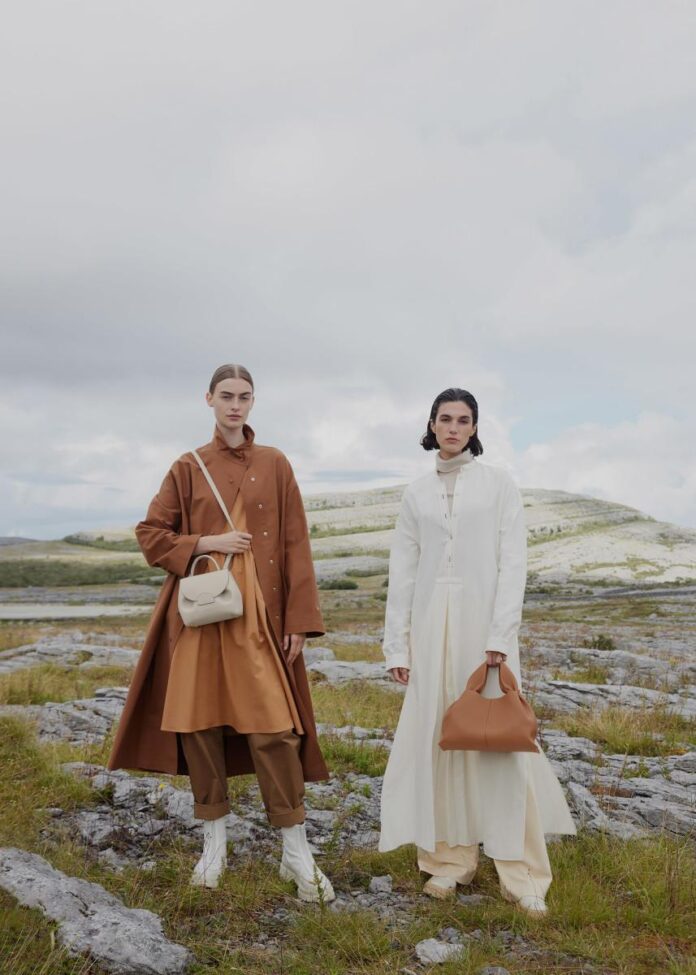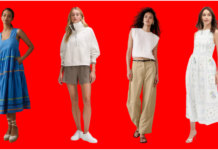In fashion, to be as effortlessly chic as the French is a common pursuit. Onlookers can buy all the right things, cut their hair in all the right places, distress their jeans and smudge their lipstick and tousle their blouse in all the right ways, and still not have “it” — “it,” in this case, being a certain je ne sais quoi that lies in subtleties. It’s why covert garments and accessories that may cruise under the radar elsewhere are so instrumental to the Parisian fantasy: Those who know know, and those who don’t, well… We weren’t so concerned about them anyway, now were we?
This is the thought process behind Polène, a quintessentially Parisian leather-goods brand founded by three siblings in 2016. Launching with a range of handbags, Polène has steadily gained global recognition for its strong, simple designs insiders may recognize on the shoulder of some Jeanne Damas-type. As is customary across the French-girl myth, you won’t find splashy logos or flashy hardware here. The label aims to be “discreet,” instead letting its work speak for itself with pristine materials and an elegant savoir-faire. Prices are still relatively accessible, with most bags in the $300-$450 range.
“Our point of view, and also the whole idea of the company, is to build something from the product, from the design, from the quality, from the story,” says co-founder Antoine Mothay, who himself ventures to keep his own background private so as not to distract from that of the brand’s.
What Mothay does share about himself, however, is that he’s the middle child, sandwiched between big brother Mathieu and little sister Elsa, all of whom created Polène together. Fashion is their family business, after all: Their great-grandfather launched the iconic French clothing line Saint James, purveyor of cult-favorite Breton-stripe shirts, way back in 1889. “Its products are very high quality, pieces you can keep for many, many years,” says Mothay. “I think that gave us a taste of what good products should be.”
Still, Polène came to be by happy accident. While Mothay recalls that he and his siblings were always especially curious about leather goods (what French person isn’t?), it wasn’t until he found himself in an Hermès workshop in Madrid in 2014 that the proverbial lightbulb flicked on.
“I stood for two or three hours in front of an artisan making a bag and explaining all the details about what it takes to have the perfect bag,” he remembers.
This being peak Mansur Gavriel era, Mothay was simultaneously excited by the new crop of digitally native, direct-to-consumer brands emerging out of the United States. So he and his siblings got to work to make something of their own.
Their research and development was extensive, with the leather-goods industry in Europe — much of which is still family-run — being famously difficult to break into. Leatherworking has controlled the economies of entire towns and cities throughout Italy, Spain and Portugal since the Middle Ages, and manufacturers aren’t so keen to open their doors for any fledgling label that comes a-knocking. Mothay spent two months in eastern Europe, three months in Portugal and a whole year in Spain building out a series of systems and procedures step by step, from scratch.
The Polène Number One and Number Nine.
Photo: Courtesy of Polène
On the other side of those 18 months came the Polène product line, a tidy range of minimalist, monochromatic handbags that toe the line between classic French luxury and youthful intensity. Mothay cites nature as a primary inspiration through every rung of the process, from initial ideation to the distribution of the finished collection. One handbag, the “Tonca,” was literally influenced by the organic curvature of the humble tonka bean.
“What’s interesting about how we’ve adapted is that we never work with drawings,” says Mothay. “Drawings are so flat, but you can see our bags from all sides, and all sides have something to express.” Instead, the design studio uses 3D microfiber prototypes that, unlike a 2D drawing, can be easily manipulated to take the shape of leather. “When you see a Polène bag, it should have more of a unique shape than other bags you’ve seen.”
This, Mothay hopes, is as much due to the bags’ microfiber drafting process as it is the materials that complete them. Polène uses full-grain calf leather that comes sourced from Italian and Spanish tanneries and certified by the Leather Working Group (LWG), an international organization that claims to offer more sustainable and transparent leather goods.
Brands awarded with LWG certification, like Polène, have undergone thorough auditing across areas like chemical pollution and worker health and safety. More tanneries appear on the Environmental Protection Agency’s Superfund list (that identifies the priority environmental cleanups) than any other business type in the U.S. But this is not strictly an American problem: Almost all leather is tanned with known carcinogens like chromium, formaldehyde and arsenic, which, in turn, exposes workers to higher rates of cancer and other illnesses.
Polène knows it’s not enough to simply claim best-in-class materials anymore. For the first four years of the business, Mothay’s brother Mathieu inspected each and every piece of leather, one by one, before it was moved into production.
“He did that because quality was so important for him, to have a relationship with our partners and to let them understand how we work and what we expect from them,” says Mothay. “This is not a leather you can find with other brands.”
Inside Polène’s New York City flagship store, located at 487 Broadway in SoHo.
Photo: Courtesy of Polène
As it turns out, Mothay and his siblings are equally as obsessive about metal hardware. Polène’s come gilded with a vacuum coating called Physical Vapor Deposition (or PVD) plating, a technique used in the watchmaking industry for its long-lasting quality. It’s also more sustainable than the traditional galvanization process, in that it uses no water and no chemicals — just electricity — to bond gold with metal.
Hardware is top of mind for an upcoming category expansion into jewelry, the specifics of which remain under wraps. “Jewelry is a new area for us to express our aesthetic,” says Mothay. “Jewelry gives you more possibilities in terms of design than handbags or shoes, where you always have the problem of weight in terms of size and materials.” Speaking of shoes: That’s coming, too, a development that will delight the brand’s coterie of loyal shoppers who Mothay says have all but demanded Polène shoes for years now.
“The strategy is always to go step by step,” he says. “The company is growing really fast, and we could grow even faster, but we really want to build up a contemporary house of fashion.”
Mothay means “house” literally: In September, Polène opened its New York City flagship store (its first brick-and-mortar location in the U.S.) on a sunny, sprawling corner in SoHo. The sparse space, filled with custom wood seating and uncluttered shelving, brings shoppers deep into the recesses of the Polène brain waves. Soon, the brand continues its international tour to expand its retail footprint to Tokyo, with a new location set to open in the spring.
Right now, Japan is among Polène’s four largest markets, alongside the U.S., China and, of course, France. Because as much as Polène is Parisian elegance in a figurative bottle, it also understands the aesthetic’s global appeal, working with an ample community of influencers who showcase Polène’s products across social media the world over.
This is how I learned of the brand, after all: on the page of a niche TikTok creator who paired her half-moon-shaped Numéro Dix with slouchy jeans and Birkenstock’s Super-Birkis. The bag, though, is what pulled it all together. Or maybe that’s just the Parisian fantasy talking.
Never miss the latest fashion industry news. Sign up for the Fashionista daily newsletter.













